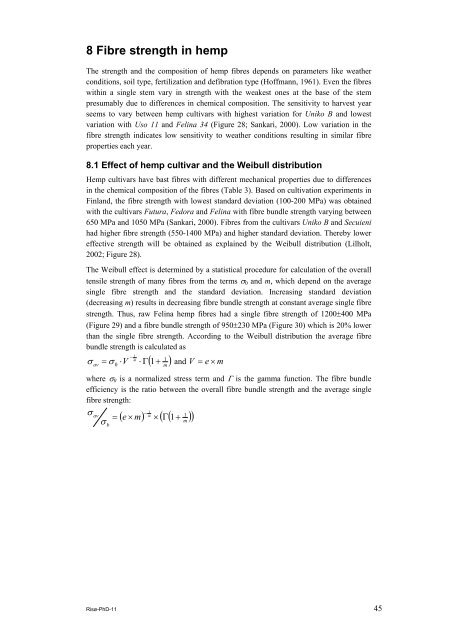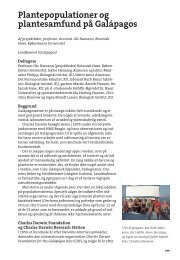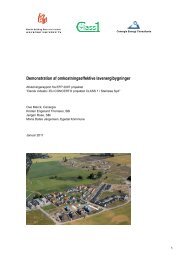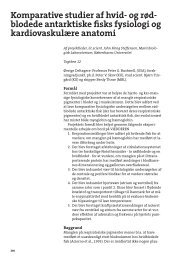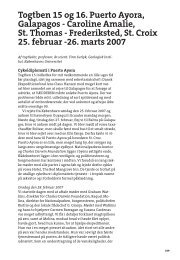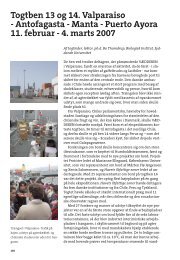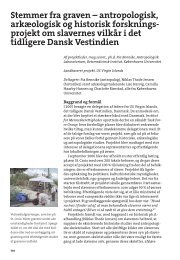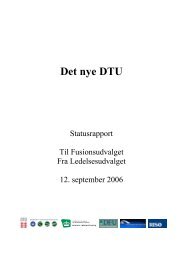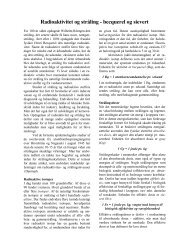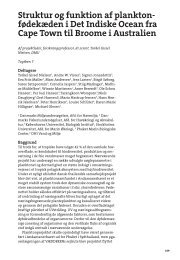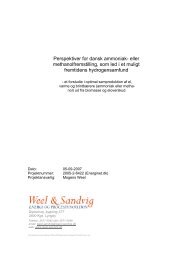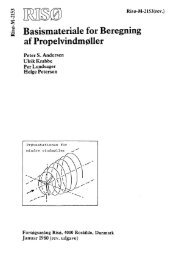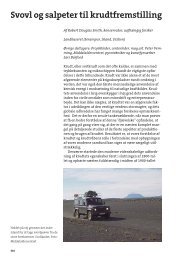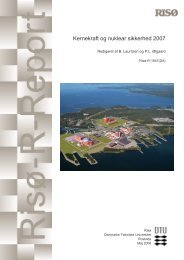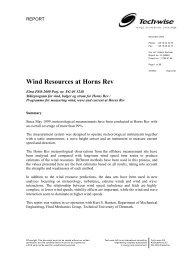Properties of hemp fibre polymer composites -An optimisation of ...
Properties of hemp fibre polymer composites -An optimisation of ...
Properties of hemp fibre polymer composites -An optimisation of ...
Create successful ePaper yourself
Turn your PDF publications into a flip-book with our unique Google optimized e-Paper software.
8 Fibre strength in <strong>hemp</strong><br />
The strength and the composition <strong>of</strong> <strong>hemp</strong> <strong>fibre</strong>s depends on parameters like weather<br />
conditions, soil type, fertilization and defibration type (H<strong>of</strong>fmann, 1961). Even the <strong>fibre</strong>s<br />
within a single stem vary in strength with the weakest ones at the base <strong>of</strong> the stem<br />
presumably due to differences in chemical composition. The sensitivity to harvest year<br />
seems to vary between <strong>hemp</strong> cultivars with highest variation for Uniko B and lowest<br />
variation with Uso 11 and Felina 34 (Figure 28; Sankari, 2000). Low variation in the<br />
<strong>fibre</strong> strength indicates low sensitivity to weather conditions resulting in similar <strong>fibre</strong><br />
properties each year.<br />
8.1 Effect <strong>of</strong> <strong>hemp</strong> cultivar and the Weibull distribution<br />
Hemp cultivars have bast <strong>fibre</strong>s with different mechanical properties due to differences<br />
in the chemical composition <strong>of</strong> the <strong>fibre</strong>s (Table 3). Based on cultivation experiments in<br />
Finland, the <strong>fibre</strong> strength with lowest standard deviation (100-200 MPa) was obtained<br />
with the cultivars Futura, Fedora and Felina with <strong>fibre</strong> bundle strength varying between<br />
650 MPa and 1050 MPa (Sankari, 2000). Fibres from the cultivars Uniko B and Secuieni<br />
had higher <strong>fibre</strong> strength (550-1400 MPa) and higher standard deviation. Thereby lower<br />
effective strength will be obtained as explained by the Weibull distribution (Lilholt,<br />
2002; Figure 28).<br />
The Weibull effect is determined by a statistical procedure for calculation <strong>of</strong> the overall<br />
tensile strength <strong>of</strong> many <strong>fibre</strong>s from the terms σ0 and m, which depend on the average<br />
single <strong>fibre</strong> strength and the standard deviation. Increasing standard deviation<br />
(decreasing m) results in decreasing <strong>fibre</strong> bundle strength at constant average single <strong>fibre</strong><br />
strength. Thus, raw Felina <strong>hemp</strong> <strong>fibre</strong>s had a single <strong>fibre</strong> strength <strong>of</strong> 1200±400 MPa<br />
(Figure 29) and a <strong>fibre</strong> bundle strength <strong>of</strong> 950±230 MPa (Figure 30) which is 20% lower<br />
than the single <strong>fibre</strong> strength. According to the Weibull distribution the average <strong>fibre</strong><br />
bundle strength is calculated as<br />
− 1<br />
m<br />
1<br />
σ = σ ⋅V<br />
⋅ Γ 1+<br />
) and V = e × m<br />
av<br />
0<br />
( m<br />
where σ0 is a normalized stress term and Γ is the gamma function. The <strong>fibre</strong> bundle<br />
efficiency is the ratio between the overall <strong>fibre</strong> bundle strength and the average single<br />
<strong>fibre</strong> strength:<br />
σ<br />
=<br />
1 −<br />
1<br />
( e × m)<br />
× ( Γ(<br />
1+<br />
) )<br />
av m<br />
σ b<br />
m<br />
Risø-PhD-11 45


